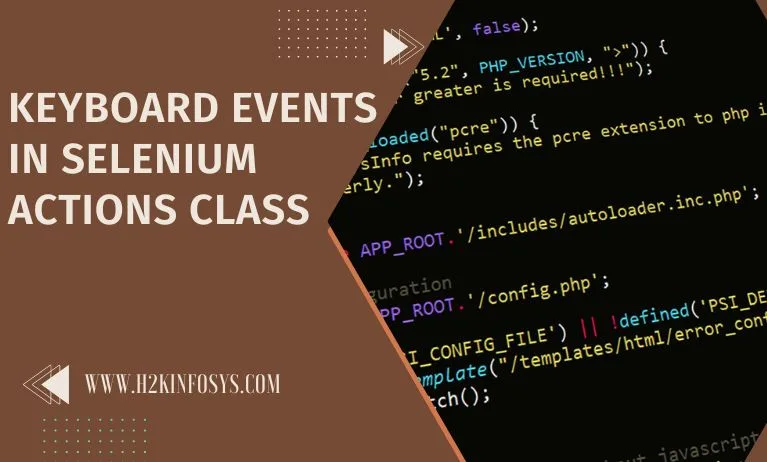Selenium has a mechanism to manage keyboard events that might simulate user motions. Consider searching “India” on the Google search engine. In order to see the search results for this, type “India” and press the Enter key. How would you simulate pressing the ENTER key in Selenium code, let’s say you wanted to automate this Google search? The ability to imitate such keyboard actions is made possible by keyboard events produced by Selenium WebDriver’s Actions class. There are selenium interview questions that ask questions related to keyboard events in the selenium Actions class, so you can check them out.
What do Selenium keyboard events entail?
Selenium provides a robust mechanism for automating keyboard interactions through its keyboard event handling capabilities. A user’s interaction with the keyboard is described by a Keyboard Event. Keyboard events occur whenever a user presses a key or a series of keys. These events are crucial for simulating real user input in automated tests, especially when dealing with forms, text inputs, or key commands.
There are several approaches to automate these Keyboard Events using Selenium, such as using the Actions class, which allows for simulating key presses, key releases, and combinations of key events to mimic real-world usage of a web application. This ensures that your tests can effectively simulate user behavior involving the keyboard..
- Use the sendKeys() function of the WebElement class to automate keyboard events.
- Use the Robot class to automate keyboard actions.
- Utilise the Actions class to automate keyboard events.
The first two methods of handling keyboard events using the “sendKeys()” function of the WebElement class and the “Robot class” of WebDriver were already covered in the articles provided by the corresponding links. We will discuss the specifics of Selenium WebDriver’s “Actions” class in this article. Let’s first examine why particularly the “Actions” class is required to handle those keyboard events before delving deeply into its fundamentals.
Why is the Actions class needed to perform Keyboard actions using Selenium WebDriver?
There are different circumstances when the user does the following actions when interacting with a web application:
- Wherever the user needs to type a word or letter in capital letters, they simply press the “SHIFT” key and enter the required characters. Any characters entered while holding down the “SHIFT” key will type as a capital letter.
- Copy and Paste Text: Text can be copied and pasted by selecting it with the “CTRL+A” keyboard shortcut, copying it with the “CTRL+C” key, and pasting it into a new text box by simply clicking in the existing text box and using the “CTRL+V” keyboard shortcut.
These are pretty typical user behaviours that we engage in virtually daily.
Now, Selenium WebDriver offers two options, as we previously covered, to transmit any keyboard event to a web element:
sendKeys() method of WebElement class.
Actions class
Let’s try to explore in more depth how the sendKeys() method of the WebElement class may be used to automate the above-mentioned scenario of inputting capital letters while holding down the SHIFT key.
Although WebElement’s sendKeys() method permits the use of the Control Key, copying and pasting is not possible since the key sequences are not combined. Moreover, it placed the letter “V” in the Permanent Address text field rather than the contents of the Current Address.
When the text of these two fields is compared, the assertion fails because the text of the Current Address text field was not copied to the Permanent Address text field. So, the test above fails with an error message when we run it.
Therefore, this is the problem with the WebElement class’ sendKeys() method. To put it another way, it doesn’t work when we need to combine special keys like “SHIFT,” “CONTROL,” etc. Using any web program, as users, is frequently the case with the various key sequences, as we all know.
The Selenium WebDriver Actions class, which offers a variety of methods to particularly handle operations of these meta keyboard keys that must be pressed while carrying out operations on the other keyboard keys, enters the picture as a result. Let’s look at how the Selenium WebDriver Actions class may be used to handle such keyboard actions.
What is an Actions Class in Selenium WebDriver?
As shown above, the “Actions” class in Selenium WebDriver has a number of methods that can be used to automate and simulate keyboard and mouse actions.
What are the various Keyboard Events Actions class methods available?
The Actions class primarily offers the following three methods for emulating the keyboard events, as shown in the screenshot up top:
sendKeys()
Sends a string of keystrokes to a specified web element using the sendKeys() function. Two formats of this approach are overloaded:
SendKeys (CharSequence, KeysToSend): This function transmits a series of keys to a web element that is now focused, therefore if we want to send a specific character to a web element, we must first focus the element in question before sending only the specified character to it.
- sendKeys(WebElement element, CharSequence.KeysToSend): This particular implementation of the sendKeys() method transmits a series of characters or keys to the particular web element specified in the method’s first parameter. This technique executes the same action as sendKeys by first concentrating on the target web element (CharSequence keys).
keyDown()
When a particular keyboard key has to be pressed, this function simulates a keyboard action. So, we can utilise the keyDown() method to keep the key pressed anytime you need to press a key and then carry out specific other tasks. Take the case where a user needs to input some characters in capital letters. So, to mimic user behaviour, the user would press the SHIFT key before pressing the necessary capitalization-required characters. This approach is also accessible in the following two overloaded variants:
- keyDown(CharSequence key): By using this method, the key given is pressed on the focused Web Element. This technique typically involves pressing “Modifier keys” like SHIFT, CTRL, etc. This technique must be used after the target web element has been explicitly focused if you want to press a keyboard key on that web element.
- keyDown(WebElement element, CharSequence key): This method presses the key on the web element that has been supplied as a parameter to the method after first focusing on the web element that has been passed as a parameter.
KeyUp()
This method is frequently used in conjunction with KeyDown(). The keyboard key that is pressed using the keyDown() method is not automatically released; therefore, it must be released deliberately using the keyUp() method.
- keyUp(CharSequence key): This method releases the designated key on the focused Web Element at the moment. This method must first be used to specifically focus on the web element you want to release the keyboard key on before you can use it to release the key on any other web element.
- keyUp(WebElement element, CharSequence key): This function first concentrates on the web element, which is supplied as a parameter to the method. The stated key is then released on that Web Element.
Conclusion
Keyboard events in the Selenium Actions class are essential for simulating realistic user interactions within automated tests. By leveraging the powerful features of the Actions class, testers can simulate key presses, key combinations, and key releases to interact with form fields, navigation elements, and other keyboard-driven actions on a web page.
This capability ensures that automation tests accurately reflect how users would interact with a website or application, improving the test coverage and reliability. Mastering the use of keyboard events in Selenium enhances the flexibility of your test scripts, allowing you to create more dynamic and comprehensive automated testing scenarios for various web applications.
In addition to simulating basic keyboard actions, the Selenium Actions class allows testers to replicate complex user behaviors, such as holding down modifier keys (e.g., Shift, Ctrl) while performing other actions, navigating through dropdown menus, or handling keyboard shortcuts. These advanced functionalities are crucial for testing web applications that rely heavily on keyboard interactions, such as content management systems, e-commerce platforms, and dynamic web forms. By mastering these features, testers can ensure seamless user experiences and validate application functionality across diverse use cases.
Call to Action
Unlock the full potential of Selenium automation by mastering Keyboard Events in Selenium Actions Class with H2K Infosys. Keyboard events, such as pressing keys, handling combinations, and managing sequences, are pivotal in creating robust automated test scripts. At H2K Infosys, our Selenium Online Training provides hands-on guidance on implementing these advanced features, ensuring you’re equipped to handle real-world testing scenarios with ease.
Our Selenium online courses are designed to cater to both beginners and experienced professionals, offering a comprehensive curriculum that covers everything from the basics to advanced techniques. Whether you’re preparing for a career in automation testing or enhancing your current skill set, our expert-led training ensures you’re ahead in the competitive field.
Join H2K Infosys today to gain access to industry-relevant training, practical projects, and certification that opens doors to top opportunities. Learn at your own pace, supported by seasoned professionals who guide you every step of the way. With our comprehensive curriculum and career-focused approach, mastering Selenium’s powerful capabilities has never been easier. Don’t wait transform your career with H2K Infosys’ Selenium Online Training and become a sought-after professional in the field of QA automation!

























